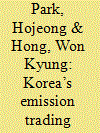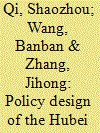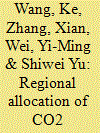|
|
|
Sort Order |
|
|
|
Items / Page
|
|
|
|
|
|
|
| Srl | Item |
| 1 |
ID:
136189


|
|
|
|
|
| Summary/Abstract |
Shanghai, as the most advanced mega city in China, has launched a pilot carbon emission trading scheme (SH-ETS) that is designed to achieve a compromise between the domestic context in Shanghai, and a need for national policy appeal. This paper gives an overview of the latest progress of the SH-ETS and sheds some light on the features of key design components, such as the threshold for inclusion, sector coverage, cap setting, allowance allocation and the Monitoring, Reporting and Verification (MRV) system. Based on a concern that manipulative principles and economic dynamics may lead to uncertainties and ultimately influence the emission reduction effect of the scheme, this paper conducts an evaluation of potential uncertainties, such as those caused by changes in patterns of economic growth, strategic trading activities related to the bankable allowances, carbon leakage risks and insufficient MRV capabilities. To advance the experiment to reality, this paper suggests some changes are made to the pilot, which include adjusting the allowance allocation principles to facilitate change in the domestic energy structure, improving the disclosure of emission data to guarantee information symmetry, gauging the carbon leakage risks to strengthen compliance, and introducing risk management for non-regulated players and derivatives products.
|
|
|
|
|
|
|
|
|
|
|
|
|
|
|
|
| 2 |
ID:
114324


|
|
|
|
|
| Publication |
2012.
|
| Summary/Abstract |
Emission trading is considered to be a cost-effective environmental economic instrument for pollution control. However, the policy design of an emission trading program has a decisive impact on its performance. Allowance allocation is one of the most important policy design issues in emission trading, not only for equity but also for policy performance. In this research, an artificial market for sulfur dioxide (SO2) emission trading was constructed by applying an agent-based model. The performance of the Jiangsu SO2 emission trading market was examined under different allowance allocation methods and transaction costs. The results showed that the market efficiency of emission trading would be affected by the allocation methods when the transaction costs are positive. The auction allowance allocation method was more efficient and had the lowest total emission control costs than the other three allocation methods examined. However, the use of this method will require that power plants pay for all of their allowance, and doing so will increase the production costs of power plants. On the other hand, output-based allowance allocation is the second best method.
|
|
|
|
|
|
|
|
|
|
|
|
|
|
|
|
| 3 |
ID:
136194


|
|
|
|
|
| Summary/Abstract |
In 2008, the government of Republic of Korea (Korea) announced the national abatement target aiming at 30% reductions from the Business-as-Usual projections by 2020. Accordingly, the Emission Trading Scheme (ETS) will be implemented from 2015 onwards. As ETS performance substantially depends on the structural design, it is critically important to examine the details of Korean ETS for the achievement of cost effectiveness and concurrent development of an active emission trading market. This paper addresses several policy design issues for this purpose. After providing an overview on the current framework of Korean ETS, we propose ways to achieve flexibility, consistency and market efficiency of the program in consideration of the preexisting policies. Issues in policy design are discussed by focusing on allowance allocation, market stabilization measures and price mechanism in the emission and energy markets in Korea. This paper will serve as a practical guideline for establishing sustainable and market-efficient Korean ETS that can be compatible with the international standards as in the EU ETS.
|
|
|
|
|
|
|
|
|
|
|
|
|
|
|
|
| 4 |
ID:
136190


|
|
|
|
|
| Summary/Abstract |
Of seven pilot emissions trading schemes (ETS) being run in China, the ETS in Hubei province is the only provincial pilot in the central and western regions of the country with a high GDP growth rate and heavy industrial structure. As such, it is quite representative of China as a whole and its ETS will therefore be reasonably characteristic of a future nationwide market. This paper describes the policy design of the Hubei ETS, including aspects of coverage, cap, allowance allocation, transactions, compliance and penalties. Then, after making a comparison with the other Chinese pilots and emissions trading schemes in the European Union (EU) and California, the paper offers a summary of several distinct features of the Hubei ETS. First, the small numbers of entities that are covered by the scheme produce a considerable proportion of the emissions. This makes Hubei the world׳s third largest carbon market. Second, the Hubei ETS applies several mechanisms to deal with the province’s rapid growth rate. Third, the scheme׳s policy design emphasizes liquidity. In addition to these unique features, the Hubei ETS also shares some common features with all the pilots in China.
|
|
|
|
|
|
|
|
|
|
|
|
|
|
|
|
| 5 |
ID:
118837


|
|
|
|
|
| Publication |
2013.
|
| Summary/Abstract |
The mitigation efforts of China are increasingly important for meeting global climate target since the rapid economic growth of China has led to an increasing share in the world's total CO2 emissions. This paper sets out to explore the approach for realizing China's national mitigation targets submitted to the UNFCCC as part of the Copenhagen Accord; that is, to reduce the intensity of CO2 emissions per unit of GDP by 40-45% by 2020, as well as reducing the energy intensity and increasing the share of non-fossil fuel consumption, through regional allocation of emission allowance over China's provinces. Since the realization of China's mitigation target essentially represents a total amount emission allowance allocation problem, an improved zero sum gains data envelopment analysis optimization model, which could deal with the constant total amount resources allocation, is proposed in this study. By utilizing this model and based on several scenarios of China's economic growth, CO2 emissions, and energy consumption, a new efficient emission allowance allocation scheme on provincial level for China by 2020 is proposed. The allocation results indicate that different provinces have to shoulder different mitigation burdens in terms of emission intensity reduction, energy intensity reduction, and share of non-fossil fuels increase.
|
|
|
|
|
|
|
|
|
|
|
|
|
|
|
|
|
|
|
|
|